|
|
 |
Canadian Historic Sites: Occasional Papers in Archaeology and History No. 16
The Cochrane Ranch
by William Naftel
The British American Ranche Company
Regrouping
Cochrane had reserves and an alternative plan and as soon as it be
came apparent that disaster had struck for the second winter in
succession, he began to deploy the resources he had been husbanding.
On 21 March 1883 Cochrane was assigned the leases of the Eastern
Townships Ranche Company and the Rocky Mountain Cattle Company held by
his political confrères, Brooks and Colby.1 In addition,
lease No. 26 held by Gagne, Pratt and Company and totalling 64,000 acres
was assigned to James Cochrane. These three assignments received
cabinet approval on 17 April and provided the Cochrane ranch with
170,500 acres of grazing land running southwest from Fort MacLeod
between the Peigan and Blood Indian reserves, and between the Belly and
Waterton rivers to a line of latitude just south of the present town of
Cardston and close to the international boundary. This actually did not
effect the possession of the company's lease of 100,000 acres or so of
grazing land along the Bow River and it is a commentary on the
senator's determination that although he claimed to have personally lost
over $100,000 on his Canadian ranching operations,2 there
seems to have been no question of abandoning the leases. With $15 to $20
thousand tied up in fencing and buildings alone, he had no intention of
writing it off.3
All that was therefore required was an about-face on the subject of
sheep ranching to which he had been so firmly opposed two years before
and this switch was accomplished without much trouble. As early as March
it had become evident to Cochrane that the Bow River leases were "better
adopted for a hardier animal like the sheep," and examples in Montana
could be quoted to show that if the technique known as "close herding"
were adopted, flocks of sheep might graze in cattle lands without the
anticipated damage occurring.4 Again the forces were
marshalled and Colby, who had previously protested strongly against the
grazing of sheep, was persuaded to state that there was ample room in
the Northwest for both cattle and sheep ranchers,5
This conversion prompted a few cynical remarks from David Lewis
Macpherson the new minister of the Interior, and Macdonald.6
The prime minister, moreover, was getting a little edgy on the subject
of ranching companies. Some
8 or 9 companies got Ranches on giving the assurance that they
were both able and willing to stock them. It turns out that they all
lied and merely got their leases for the purpose of selling them....
These speculators [he was not referring to Cochrane] now club
together to make one large Company with a range [?] the size of a
province to speculate upon, and propose to hawk this around in
England.7
Cochrane, however, was immune to difficulties. They could be swept
away in no time. He wanted to raise sheep, he wanted to do it with no
restrictions on numbers, and if Sir Joseph Pope, the prime minister's
secretary, would kindly arrange a meeting with Macdonald, all could be
arranged in a very few minutes.8 Though it took nearly four
months of continual nagging from the end of March until the beginning of
July, the Department of the Interior finally gave in and on 11 July the
company was informed that they might graze sheep on the Bow River leases
on condition that they place five head of sheep for every ten
acres.9
There seems, however, to have been a quid pro quo involved, in
that this concession was seized upon as justification for finally
rejecting Cochrane's claim that the company should be allowed to
purchase five per cent of its leasehold, which claim he had been
pressing vigorously up to this point. However much of an non
sequitur the comment may seem, Macpherson observed that, in view of
Cochrane's desire to withdraw his cattle and replace them with sheep,
the company had therefore lost all claim to purchase five per cent of
the leasehold.10 The senator may have accepted this as part
of a bargain; certainly the flow of letters on the subject from himself
or his agents stopped once he received permission to graze sheep.
This, however, did not solve the entire sheep-versus-cattle question
and the matter was the subject of much debate in the grazing country
where a number of persons were expressing keen interest in sheep
raising. Petitions pro and con were forwarded to Ottawa: the South
Western Stock Association of Fort MacLeod urged that sheep not be
permitted in its territory: 124 residents of the Sheep Creek and High
River areas asked that sheep not be banned from their
district.11 During a visit to the Northwest in the summer of
1884 the deputy minister of the Interior, Burgess, discussed the subject
with various interested parties and the result was the formulation of a
new policy. Henceforth sheep were free to graze without permit in the
territory north of the Highwood and Bow rivers, while south of that line
the grass was reserved for cattle alone.12
Unlike the American situation, the bitterness between sheepmen and
cattlemen never developed to any great extent although it was certainly
there and from available evidence it would seem that the boundary
arrived at was mutually satisfactory The decision is perhaps most
interesting for the purposes of this paper insofar as it reflects the
decline in favour of the Bow River district in the eyes of cattlemen. In
1881 it had been considered the prime cattle grazing country by experts
and investors. After two disastrous winters for the Cochrane stock, its
abandonment to sheep raised scarcely a murmur from the big ranchers
whose centre was now Fort MacLeod.
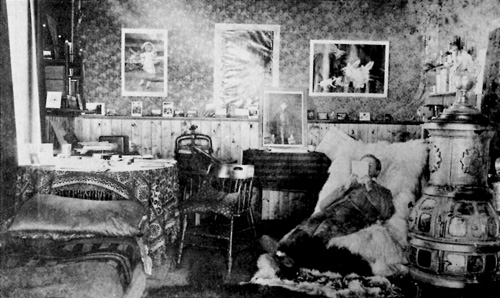
21 Living quarters of the British American ranch, circa 1886, Ernest
B. Cochrane on the couch.
(Glenbow Alberta Institute.)
|
Establishment
As soon as matters were well in hand on the new range at Fort
MacLeod, attention was turned once more to the Bow River leases and in
February 1884 a new company, the British American Ranche Company, was
incorporated to handle them. The new company did not arrive in a very
happy atmosphere for the collapse of cattle ranching at Big Hill after
two costly years had led to strains in shareholder relationships and
management in both the East and the West. At Big Hill the capable
Kerfoot had threatened to resign in January 1884, probably over
disagreements with Montreal. In Montreal the annual meeting of the
shareholders of the Cochrane Ranche Company in February 1884 was
characterized by some bitter in-fighting. McEachran at one point accused
White, Browning and Cochrane of holding private meetings on company
business behind his back, while Browning and Cochrane accused McEachran
of doing all he could in his power to ruin the credit of the company and
by his conceit and pomposity hindering his own advancement.13
The meeting was generally an unpleasant one and one of its
accomplishments was a surreptitious move to dismiss White. This came to
nothing when McEachran refused to co-operate.14 In the end it
was left to Cochrane to remark tactfully while he was out West in July
that the directors would be glad if White would relieve them of the
expense of management as soon as he could do so without loss to
himself.15 The implication seems to be that White was a
scapegoat for the company's difficulties. He had already been replaced
as treasurer that spring by A. E. Cross.
On a more constructive level, this particular meeting made
arrangements to dispose of the Cochrane ranch holdings to its new
corporate entity, the British American Ranche Company.16 The
new company may have been formed more from the necessity of preserving
the government from embarrassment than any other reason for under the
terms of its charter the Cochrane Ranche Company could have raised sheep
and horses without the necessity of another incorporation. In strictly
legal terms, the statutory limit of 100,000 acres per lessee was not
encroached upon as the over one-quarter million acres controlled by the
Cochrane Ranche Company around Calgary and around Fort MacLeod was held
in the name of a variety of separate individuals and corporate entities.
Nevertheless, perhaps for political reasons or possibly as a means of
raising new capital, the company was established which had the effect of
whittling the acreage down to a size more in keeping with the spirit of
the law.
On 19 January 1884 Cochrane, Hugh MacKay, William V. Lawrence,
William Cassils, Charles Cassils and William Ewing, all but Cochrane
residents of Montreal, submitted a petition for Letters Patent of
Incorporation for the purposes of "breeding and rearing of horses, mules,
sheep, cattle and swine" in the North-West Territories. The proposed
capital was $200,000 to be divided into 2,000 shares of $100 each of
which 1,030 were subscribed by the petitioners. The largest shareholder
was William Cassils with 420 shares, but 400 of these were held in
trust. The senator held 300 and his son-in-law, Charles Cassils, held
50.17
The required letters patent were granted on 5 February and two weeks
later on 19 February the new company bought the Bow River leases from
the Cochrane Ranche Company for $55,000.18
The way was not all clear yet for the Department of the Interior of
1884 was not the relatively compliant institution of 1881. In March 1885,
following the example of the parent company, the British American Ranche
Company filed assignments for leases totalling 189,000 acres. This
covered the 100,000 acres of the original Cochrane lease, the 55,000
acres of ranch No. 44 originally leased to Baynes and in December 1882
assigned by him to Browning and the 33,000 acres of ranch No. 43 leased
to A. W. Ogilvie and assigned by him to the Cochrane Ranche Company in
June 1884.19 Once these assignments were filed, the
department consulted the Department of Justice on the legality of
registering them. The Justice Department replied that whatever the
original intent of the legislation, nothing specifically forbade the
assignment of leases.20 Accordingly, approval was given on 26
May 1885.
Horses
The British American Ranche Company had been incorporated for nearly
a year before it took possession of the leases. In the interim, between
the time the cattle left and the British American Ranche Company became
an active operation, Kerfoot introduced an aspect which had hitherto
played a minor role — horse ranching.
By June 1883 about 490 horses were on the range south of the
Bow21 and over the next few years these were built into a
good-sized herd: 550 head in May 1885 and 609 by September of that year.
In November 1886 after the purchase of the "Harper Band,"22
one of the finest herds in the West and probably from the Gang ranch in
British Columbia, the horses, now legally part of the British American
Ranche Company, reached their peak in numbers — 1,013. A year later
there were 964 horses and at the time of the sale of the assets and
transfer of part of the lease to the Bow River horse ranch in August
1888 there were 920 horses.23 The number of pure-bred
stallions imported to raise the quality of the stock began with four,
two thoroughbreds and two Clydesdales. This was increased in 1885 by
four half-bred Percherons and then, with the addition of the Harper band
in 1886, to a total of eight thoroughbreds and six half-breds, with an
emphasis on the Clydesdales and Percherons. At the time of the sale
there were nine thoroughbreds and one half-bred.
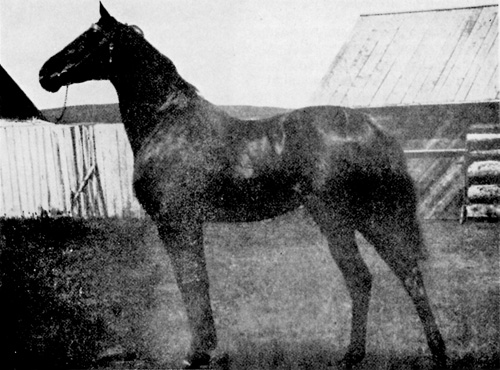
22 Konrad, foaled in 1874 by Rebel Morgan and brought in with
Cochrane's first herds, was the first thoroughbred in Alberta.
(L. V
Kelly, The Range Men: The Story of the Ranchers and Indians of
Alberta (Toronto: Briggs, 1913.)
|
Horse ranching became a major part of the British American Ranche
Company's operations and to handle it the lease was in effect divided in
half. Buildings and corrals were erected on the south bank of the Bow
River where Jumpingpound Creek debouches. This involved the expenditure
of a fair amount of capital so it is evident that a good return was
expected.
The demand it was intended to supply was a mixed one. It is evident
from the proportion of heavy draught animals among the stallions that
much of the market was expected to be homesteaders looking for farm
animals to pull plows and wagons. Cowboys' interest was expected and
great hopes were placed in the need of the North-West Mounted Police for
remounts. However, none of these markets developed to any great extent.
Settlement lagged even after the completion of the CPR and the expected
population explosion simply did not occur for another decade. Cowboys
were a limited market and initially it proved exceedingly difficult to
persuade the Mounted Police to buy their horses locally rather than from
eastern breeders. The effort was hardly worthwhile. The decision to
dispose of the Bow River properties was taken in late 1887 and the
buildings, implements, lease and lands of the horse-ranching operation
south of the Bow River were sold to the Bow River Horse Ranche
Company.24
Sheep
In stocking the new sheep ranch, the same procedure was followed as
had been used for starting a cattle herd: foundation stock was imported
from the western United States, mostly Montana and Wyoming, and purebred
rams were brought in to gradually raise the quality through careful
breeding. The American stock was mostly Merino and Rambouillet in
background, crossed with Shropshires or Oxfordshires.25 In
April 1884, along with the announcement of the purchase of the Bow River
operations, the British American Ranche Company also stated its
intention of importing some 6,000 sheep.26 The actual number
imported, however, may have been rather more, somewhere between 7,000
and 8,000 depending on which of the available figures are
used.27 The purebred stock consisted of some 2,000
Shropshire rams which arrived on the ranch in
mid-October.28
The usual jinx seemed to be operating when the arrival of the sheep
was signalled by a heavy snowstorm, but then the situation began to
improve. For one thing, the sheep had been driven slowly and were in
good shape — "fat as butter" was one comment.29 For
another, despite the early snowstorm, the winter of 1884-85 was the
kind that the publicists wrote about — mild and open — so the
sheep were able to forage on their own, requiring no hay until February.
By mid-February the snow had vanished, the streams and springs were
reopening, and the sheep had come through splendidly. Thus far the
operation gave every prospect of bearing out the hopes of its promoters
and of the deputy minister of the Interior, Burgess, who felt that is
was bound to become a valuable industry within a very short
time.30
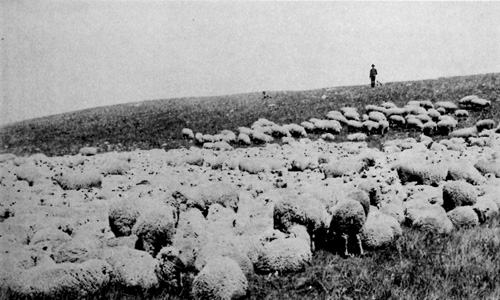
23 A band of sheep on the British American ranch, circa 1885-88.
(Glenbow Alberta Institute.)
|
With all this cheerful outlook after the successful wintering of the
herd had become a matter for public comment, disaster struck when a
prairie fire caught some of the sheep and 400 died in the
flames.31 It was a bitter blow and Kerfoot stated publicly
that the fire had been deliberately set in order to damage the stock.
Nothing more was heard of this charge, but it was an indication that the
emotions which sparked bitter range wars in the United States were not
entirely absent from the Canadian experience.
Nor was this the last misfortune. L. V. Kelly records that a corral
into which had been herded a large flock of sheep was drifted in during
a late snowstorm, allowing the sheep to wander off over the fence.
Driven by the storm, they headed across country until they come to a
deep slough three miles away and there 300 drowned. Another heavy loss
is said to have occurred at lambing when "hundreds and hundreds" of
ewes died giving birth.32
Possibly because of these misfortunes, Browning qualified the
company's commitment to stock the range with the statement that the
sheep had been placed on the range, "with a view to testing the fitness
of that . . . section for sheep grazing."33 Late spring saw
the company with about 8,000 sheep which may or may not represent an
increase as two sets of figures are available for the number of sheep
actually imported. Even after the main lambing season was well over, the
size of the flock had increased to only 8,200. The sheep ranching
operations of the British American Ranche Company never developed beyond
this stage. In late 1866 there were 7,525 sheep on the ranch, the
following year, 7,439, and in 1888 8,570.34 Proposals to
erect a woollen mill near Calgary did not come to fruition until long
after they were first made in 188335 and the wool clip, which
in the first season amounted to 50,000 pounds, was sent to Montreal for
disposal.36
Though the British American operations, both sheep and horse, never
suffered the major setbacks of its predecessor on the site, there was
never any of that run of good fortune so necessary in the initial years
of a new operation. Management troubles persisted and in 1887 Kerfoot
resigned. It appears to have been the same old story of conflicts
between an eastern-based management and a western operation and many
disagreements arose when directors' decisions had unhappy results for
which Kerfoot received the blame.
Kerfoot's resignation was a stormy one and he eventually sued the
company successfully for the remainder of the salary due on his
five-year contract.37 Nevertheless, he remained bitter over
what he considered his bad treatment by the management. He went into
ranching in partnership with his father-in-law, W. Bell Irving, just
west of the British American ranch lease, and prospered. He died in 1910
in the parade of the Spring Stock Show in Calgary when his horse fell
and crushed him.38 His replacement as manager was Ernest
Cochrane, the senator's youngest son, who might be expected to be more
amenable than his predecessors to direction from Montreal.
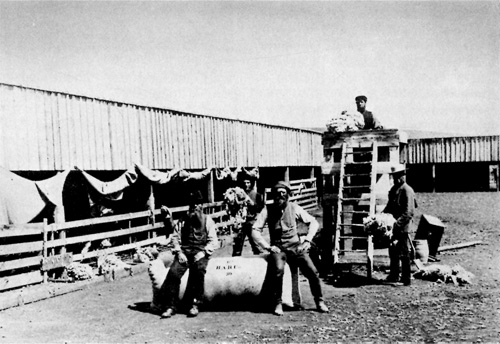
24 Baling wool on the British American ranch, circa 1885-88.
(Glenbow Alberta Institute.)
|
There were other problems. L. V Kelly mentions such things as
disease, bad water, unfortunate accidents, thieves and
storms.39 One major difficulty was presented by wolves which,
deprived of the buffalo, found a welcome substitute in the herds of
cattle and sheep which replaced them. The company kept a pack of
wolfhounds which proved useful in controlling the wolves, but losses
remained high.40
Possibly of more moment than the various handicaps imposed by nature
were those imposed by man, of which two, rental and markets, will be
noted briefly and the third, instability of the leases, discussed in
some detail. In 1885 the rental of the leased lands had been doubled
from one cent to two cents per acre. When dealing in tens of thousands
of acres, such a rise was not insignificant although even by the
standards of the day the rental still seems a bargain.41
Though it roused the protests of George Stephen, president of the CPR,
who saw one of the few prospects of long-haul freight diminishing before
his railway had scarcely got up steam, the Department of the Interior
stood firm.
As far as markets were concerned, the company had the misfortune to
enter the field just as Australia was rapidly developing into the
leading wool and mutton producer in the world. Between 1881 and 1891 the
number of sheep in Australia increased from 78 million to 125 million
and concurrently the price of wool dropped to a level that made life
difficult for Canadian producers.42 William Pearce summed up
the situation in Alberta as it stood in 1889.
The low price of wool has retarded this industry, which when
prosecuted on a large scale does not appear to have been a highly paying
enterprise; at the same time, in every case where a settler has not had
more sheep than he could personally look after — that is a flock of
from 500 to 2,500 — it has proved most
profitable.43
Assaults on the Leasehold
Probably the most serious and certainly the most interesting of the
problems which led to the winding up of the British American Ranche
Company were those connected with maintaining the leasehold intact, a
problem which remained insurmountable not just for the Cochrane
interests, but also for every rancher in the Northwest. Two forces were
acting to break up the leases: the corporate interests of the CPR and
the Hudson's Bay Company, and the individual interests of the
homesteader-squatter. Of the two, the CPR and the Hudson's Bay Company
were acceptable because they operated from a statutory basis and
acceptance of their land claims was inherent in signing a lease, but the
squatter was dangerous because he acted outside the law, considering it
of no account in the face of his land hunger.
The CPR had been granted 25 million acres of land in the Northwest
which its agents were to choose from the odd-numbered sections and the
Hudson's Bay Company received, in addition to a cash settlement, 1/20 of
the land in the fertile belt. The Cochrane leases stood athwart the main
railway line as it was announced in September 1882 and the CPR and the
Hudson's Bay Company were well aware of this convenient location. Hence
the lands were a prime target and considerable areas were turned over to
the two companies. Up to 1 November 1886 this had totalled 37,160 acres
and over the next two years the total mounted rapidly until by 1 May
1888, a total of 116,394 acres were withdrawn from the operation of the
lease.44 This was not the set-back it might seem for the
companies had no intention of disposing of them immediately and were
quite content to continue leasing arrangements. Nevertheless over the
ranching company's objections,45 they had now to pay rent to
at least two different masters, the government and the companies,
one of whom might dispose of its holdings at any time with a minimum
of notice. Ownership of half of its leasehold by a private corporation,
while it does not seem to have hampered the ranching operations in any
way, added one more element of insecurity to those which already
existed.
Of a much more serious nature were the actions of the agricultural
squatters who plagued every large ranching outfit in the Northwest.
Squatters were living proof of the adage, "The grass is always greener
on the other side of the fence." It is difficult to support their
actions especially in the early years before the turn of the century.
With countless millions of acres of some of the finest agricultural
land in the world free for the asking between Winnipeg and the Rockies
on fulfilment of minimal conditions, some individuals headed straight
across the empty prairies to the reserved grazing leases. There they
settled on some spring or stream, declaring that no other spot would do
and that anyone who suggested they move elsewhere was a tyrant and a
despot.
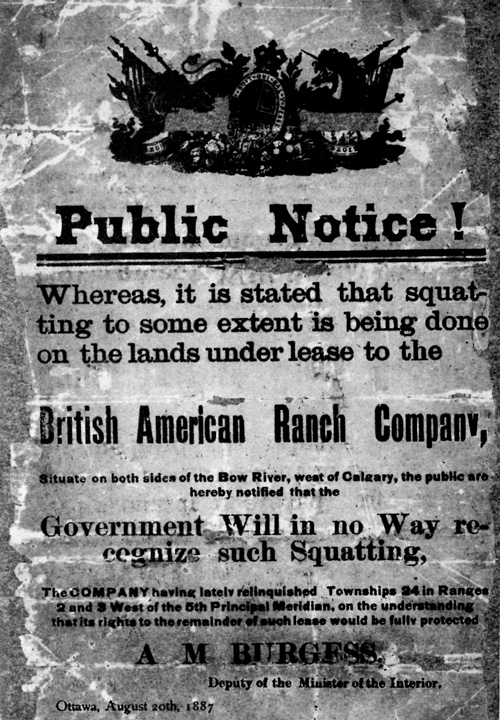
25 Notice to squatters.
(Public Archives of Canada.)
|
In resolving this problem, Macdonald's government was of very little
help for, though the lease-holders clearly had the law on their side,
the towns, which resented any restriction on settlement and hence
business, and the settlers represented heavy political pressure. The
government learned early that any strong action was interpreted as
aiding vested interests in suppressing the "little man." Worse still,
in its immigration propaganda it had consistently given the impression
that every single acre in the Northwest was available for
homesteading.
The problem was compounded by the fact that while many of the
squatters seem to have been genuinely interested in settlement, others
were well aware of their own nuisance value and in many cases they made
it clear that they would be willing to move on if they were compensated
for their "improvements."
The first open challenge to the position of the lessees came early.
At a settlers' meeting held in Ellis's billiard hall in Calgary on 10
October 1882, called to discuss the system of reserving land from
settlement for ranches, townsite reserves or Indian reserves, a resolution
was carried unanimously which stated, among other things.
That whereas the Dominion Government has seen fit to grant leases
for cattle ranges already, covering nearly all the good agricultural
land in the best portion of the proposed Province of Alberta. . . . That
it is also the opinion of this meeting that the provision in the leases
empowering and compelling the lessees of cattle ranges to prevent the
location of settlers upon the land so leased, is objectionable and
contrary to the best interests of the country.46
The most interesting feature of this resolution was the fact that its
mover, E. A. Baynes, was Cochrane's son-in-law. While he and Cochrane
never got along well,47 it seems unlikely, at least at this
early stage when his connection with the Cochrane ranch was close, that
Baynes would have moved such a resolution without the senator being in
some way aware of what he was doing. Certainly he would be representing
the views of the Cochrane ranch when he objected to an amendment to his
resolution (which nevertheless received an overwhelming majority) that
the ranchers be given two years notice.48
There is a possible explanation for the anomalous position taken by
Baynes in moving his resolution. Slightly rephrased, it would in fact
approximate the position of the Cochrane ranch and the other working
ranches as well. In an 1884 interview Browning stated the company's
position at that time.
While the ranchmen claim that they have the entire rent of the
land leased to them, they have no desire to exclude bona fide
settlers from such portions of their leases which may not be
necessary for grazing purposes. The trouble heretofore has been in
squatters, not settlers, going upon choice hay lands, valuable river
fronts, and lands with springs which are absolutely necessary for cattle
during winter, with no intention of settling, but with the object of
being bought off or selling their pretended rights to innocent
settlers. What the ranchemen think they are entitled to is that parties
desiring to settle upon their leases should ask and receive permission
to do so before attempting to take possession, and where there is not
good reason for refusing their request, they may rely upon being allowed
to occupy the land.49
As expressed, this viewpoint was reasonable enough to appeal to the
new deputy minister of the Interior, A. N. Burgess, on his first trip to
the Northwest during the summer of 1884. While in the grazing district
he discussed the question with a number of the lessees and found all but
one or two in favour of the location of settlers on the leases. He
concluded that despite efforts to create an impression to that effect.
no necessary or natural conflict existed between the agricultural
settlers and the grazing leaseholder. He illustrated his contention with
reference to the problems of the Cochrane herds, suggesting that had
there been scattered throughout the lease from 50 to 100 settlers
engaged in mixed farming from whom hay could have been purchased, a large
proportion of the cattle lost might have been saved. Aside from that,
the presence of settlers would mean a ready supply of extra help at
round-up time. On the other hand, he noted firmly, those who trespassed
on the leases with the idea of going into competition with the lessee,
probably using his bulls and stealing a few calves now and then or with
the intent of extorting some consideration for leaving, deserved no
sympathy.50
So eminently reasonable was this view that Macdonald accepted it. It
was absurd, he said, to suppose a great industry which would supply the
remainder of the Northwest with their stock cattle could be allowed to
be destroyed at the mere caprice of a few squatters. The government
would not, he continued, allow its policy in this matter to be impeded
by every squatter who chose to come in on these lands when there was
plenty of land in other parts of the country.51
Unhappily for the ranchers, this was about as far as government
action went and despite the fine words they were left pretty much to
deal with the situation as it arose. In these early years the ranchers
almost invariably eschewed violence and resorted to legal proceedings or
else made the required payment for "improvements." Hence in May 1883
White bargained with a couple of squatters named Heath and Jones who had
settled on the southern range. White offered them $800 to get off, but
they held out and received $1,000 "for their improvements."52
This attitude, in sharp contrast to the direct action with gun or rope
so common in the United States, is at least partly explained by the
prevailing philosophy of law and order. At one time rustlers were
flourishing in the Pincher Creek area and a group of ranchers met to
discuss the menace. The identity of the culprits was suspected and many
felt that action should be taken; lynching was one remedy suggested and
feeling was running high. At this point one of the leading men, E. W.
Godsal, said, "But, gentlemen, the British just don't settle matters in
this way." To this there could be no argument: the meeting ended and
they all went home.53
As the railway grew closer, however, would-be settlers became more
frequent and tempers grew shorter. Whether for blackmail or for farming
purposes, the settlers picked the finest locations on springs and river
flats. By 1887 25 miles of continuous fence between Fort Kipp and Slide
Out on the Belly River shut out the range cattle from the water and the
shelter of the valley.54
The attitude of sweet reasonableness which had prevailed did not
interest those eager for land. No matter how polite the procedure, an
eviction was an eviction and all of those whose title to their land was
vague watched with increasing uneasiness as ranchers exerted themselves
to maintain their leases inviolate. The resentment of squatters and
settlers at the refusal of the government or the ranchers to concede
immediately what was considered to be the "right" of homestead entry
boiled to the surface in a meeting held at the farm of John Glenn on 5
April 1885 at which was formed the Alberta Settlers Rights Association.
In the language of outrage their spokesman, Samuel Livingstone,
telegraphed the resolve of the meeting to Sir John A. Macdonald. All
the townships about Calgary ought to be immediately thrown open for
homestead entry and settlement and settlers therein who had complied
with the normal homestead requirements should be granted their patents
"immediately." Further, settlers ought to be allowed to import cattle
on the same terms as the lessees; that is, free. To reinforce their
demands and indicating the depth of feeling over the issue, the meeting
concluded by pressing for immediate action "to prevent repetition of the
trouble which now unhappily exists in these Territories" and resolved
further "that the halfbreeds in these Territories are entitled to and
should receive the same privileges as regards lands as have already been
conceded to their brethren in Manitoba."55 Coming little more
than a week after the confrontation at Duck Lake which heralded the
Northwest Rebellion, such language was extreme indeed, though it was
more temperate than John Glenn's threat uttered at the meeting to hold
his land "with a shot gun."56
In a sense, however, the result was a degree of success for the
government made immediate, if discreet, inquiries through local
contacts. The information received tended to discount the Alberta
Settlers Rights Association as a front for lawyers and
merchants,57 but actions of the government thenceforth with
regard to the leases indicate that they had recognized the political
strength if not the legal validity of the settlers' compliants.
The years between 1885 and 1892 were bad ones for the ranchers. The
two men who occupied the post of minister of the Interior during that
period, Thomas White and Edgar Dewdney, were inclined to favour the
settler. One of White's first moves was to revise the terms under which
grazing leases were held. This was done, interestingly enough, simply by
ministerial order despite, or perhaps because of, its very considerable
significance.58 This procedure avoided the requirements to
publicly proclaim an order in council or act of parliament. Under its
provisions, on leases granted in future, homesteaders were entitled to
take up land on the same terms as on Dominion lands and to settle
without first receiving permission of the lessees. Furthermore, no more
grazing leases would be approved for as long as 21 years and old leases
would be cancelled whenever opportunity offered. The old leases,
however, were not abrogated unilaterally but remained in force and
settlers were still required to seek permission if they wished to
settle. This requirement, however, seems to have become increasingly a
dead issue, so much so that Dewdney (then lieutenant governor of the
North-West Territories) was said to have told those settlers who asked
his advice to go ahead and settle on the leases and the ranchers would
not attempt to turn them off.59
The British American Ranche Company found itself in an unenviable
position with the eastern borders of its lease within a few miles of
the mushrooming town of Calgary. The position was made more awkward on
account of "many citizens of Calgary being agitators against
leaseholders."60 Accordingly under some pressure from the
Department of the Interior which in turn was under much pressure from
settlers, the British American ranch agreed to give up Township 24,
Range 2, the area of the lease closest to Calgary.61 Delay
in implementing this agreement, reached in late summer 1886, aroused
fierce resentment among settlers "who pinned their faith to the promises
of a cabinet minister who is supposed to be an honorable
gentleman."62 The minister was asked rhetorically, "how it
comes that one company hold [sic] 80,000 acres of leased land,
lying waste, with the conditions unfilled, when good settlers are being
refused 160 acres each" and it was suggested that Albertans would like
to know "which the government desire to have in Alberta, bullocks and
wethers, or settlers."63
The minister, however, was hardly neglecting the interests of the
settlers for at the end of March 1887 he was pressing Cochrane to
relinquish an additional township.64 Cochrane agreed, extracting
in return a promise that the department would do its best to protect his
rights to the balance of the lease. The minister himself wrote:
The promptness with which your Company gave up the two townships
in order to remove difficulties with settlers, makes me feel very
anxious to protect you, so far as the Government can, in your remaining
territory, and you may depend, therefore, upon our doing whatever is
properly within our power.65
He was to have plenty of opportunity to indicate the extent of his
power for Browning had just submitted a bitter complaint about the
activities and attitudes of the squatters. According to Ernest Cochrane,
who was now the manager,
Morrison was out among some of the settlers
the other day, pretending to be looking for land — he asked
one man if the B.A.R.C. Coy would not turn him off if he settled on
their lease and the fellow's answer was "Oh, show them a box of matches
and they will leave you alone" and then proceeded to tell how he was on
one of the Townships lately thrown open, but if he had not got his entry
before long he would have done some burning.66
It is unfortunate that at this juncture the company would seem to
have overstated their case, or rather had not undertaken to properly
document it. That summer Burgess visited the Northwest and made a point
of thoroughly investigating the complaints in Browning's letter. In June
and in July he paid separate visits to the range in company with Ernest
Cochrane and the superintendent of mines, William Pearce. Unhappily
for the company's credibility, all that was located, aside from some
empty houses which were possibly not even on the range, was one
squatter. On speaking to the man, nobody was more surprised than Ernest
Cochrane to learn that the man was on an odd-numbered section that he
had bought from the CPR after the ranch company had declined to buy it.
About all this trip netted the ranch company was the frosty observation
from Burgess that "The officers of the Ranche Company should inform
themselves, much more definitely in regard to the position of the
trespassers they complain of before any action on the part of the
Department would be justified."67
Much more damaging from the long-range point of view was Burgess's
advice to the minister that it would be difficult to defend warning
trespassers to move from even-numbered sections in the more remote and
less used portions of the leasehold in the face of the fact that the
company had refused to purchase an odd-numbered section in part of the
range which was valuable for its hay.68
This was unfortunate for the company and indeed for the future of the
big ranches for, as subsequent events make clear, squatters certainly
were on the land and were to cause a great deal of trouble. It is not
improbable that this incident coloured the department's attitude for
some time to come. The Department of the Interior did, however, go so
far as to approve a warning to would-be squatters that no claims to
land on the British American ranch's lease would be recognized. This
notice was drawn up by William Pearce as the result of a meeting between
Ernest Cochrane and the minister on 20 August 188769 and
widely distributed by the company as well as published in the newspaper.
but to no avail. Though Pearce, the department's man on the spot, became
increasingly sympathetic,70 in the end it made little
difference.
By the fall of 1888 some 15 squatters on the lease had openly taken
possession of choice portions. A petition in their favour was being
circulated in Calgary under the benevolent eye of D. W. Davis,
Conservative MP for Alberta, and it was signed by every leading citizen
and merchant;71 the Calgary press had been producing
indignant editorials championing the little man versus the big
company72 and on 3 August 1888 Dewdney succeeded to the post
of minister of the Interior after seven years as lieutenant governor of
the Northwest. Dewdney made no secret about his desire to people the
Northwest with industrious homesteaders and in his view hundreds of
thousands of acres locked up in grazing leases would accomplish nothing
toward that end. Publicly the department was as committed as ever to
support the legal rights of all parties, but privately the outlook was
not good for the lessees. Although the squatters case was legally shaky,
they were evidently in his favour. Concerning the petition of the
squatters on the British American ranch, Burgess (who invariably
reflected the prejudices of his superiors) advised Dewdney, "It is quite
clear that if we are to touch this case at all in the interests of the
settlers, it must be by way of a compromise."73
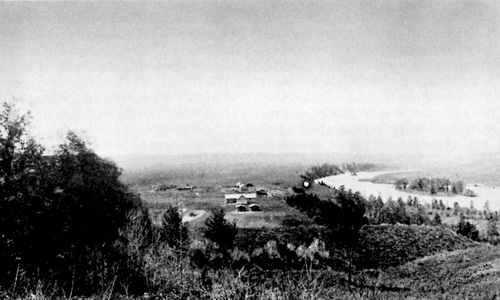
26 Bow River horse ranch, west of Calgary, circa 1885-88.
(Glenbow Alberta Institute.)
|
Withdrawal
By this time, however, the British American Ranche Company and the
Cochrane family were well on their way to withdrawing entirely from
the Bow River, a decision which had been made by November 1887 if not
before. At the annual meeting of the shareholders on the eighth of that
month the directors were authorized to sell, transfer or otherwise
dispose of the assets of the company and wind up its
affairs.74 By June 1888 all the horses and the buildings,
implements and lands south of the Bow River had been sold to the Bow
River Horse Ranche Company, an outfit financed and managed by a group of
English capitalists. The area remaining in this part of the lease
amounted to about 23,788 acres and its assignment was approved by the
cabinet in January of the following year (Fig. 29).75
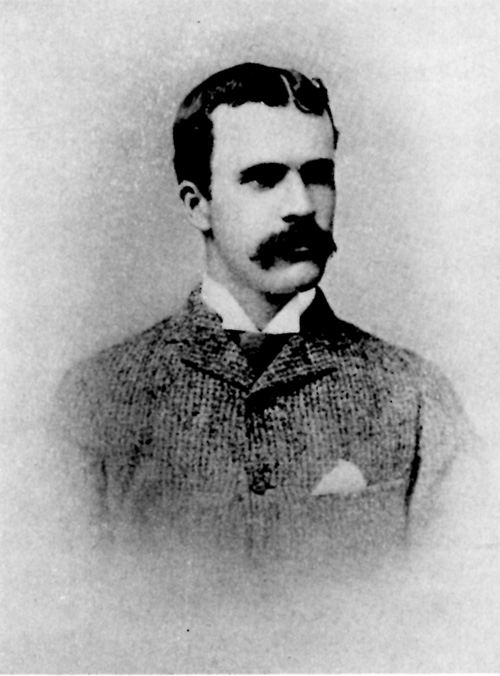
27 William F. Cochrane, "manager of the Cochrane Ranch until it sold
out to the Mormons."
(L. V. Kelly, The Range Men: The Story
of the Ranchers and Indians of Alberta (Toronto: Briggs,
1913].)
|
In June 1888 the senator had still evidently intended to keep his
hand in by some means and he took steps to retain, in the name of the
British American ranch, part of the lease north of the Bow, Township 26,
Ranges 2 and 3, and Township 25, Range 2, the rest to be given up for
settlement. Despite these adjustments in January 1889, the government
was still pressing in favour of settlers and Burgess suggested that the
company be asked to give up that part of their tract lying nearest
Calgary.76 Since they had just given up three townships, this
further request, made when Cochrane was in Ottawa for the opening of
Parliament, may have been the last straw. Whatever the reason, at a
meeting with departmental officials on 11 June, Cochrane agreed to give
up the remainder of the lease "in order that there may be no obstacle,
so far as the company are concerned to settlers obtaining entry for
lands within the leasehold,"77 on condition that the
government sell to the company three-quarters of Section 10, Township
26, Range 4 at the going rate of $2.00 per acre and grant Ernest
Cochrane homestead entry for the remaining quarter-section. This section
was the site of the company's headquarters buildings. Such a settlement
was agreeable to all. On 27 September 1890 the sale of the
quarter-sections to the company was finalized and Ernest Cochrane
obtained his patent for the remainder on 13 April 1892.78
(Ernest Cochrane's patent was cancelled in November 1900 in favour of
the Cochrane Ranche Company and in August 1905 the patent was sold
outright to Peter Collins.)
On 29 August 1888 the Calgary Herald carried an advertisement
for the sale of 7,000 head of sheep and 41,000 acres of
leasehold.79 Most of the sheep, it is said, were bought by
Thomas Ellis, a settler on Jumpingpound Creek who had come with his
family from Lanark County, Ontario, in 1886.80 The leasehold
was, as noted, returned to the government. However, the company remained
in the sheep-ranching business on a reduced scale for a short time as
they still had 4,000 sheep on the range in 1889 although officially
classed as a non-lease holder:81 evidently it was not
possible to dump an entire flock of over 8,000 sheep on the market at
once. The company itself maintained a corporate existence for some time.
In 1896 it still held title to the three quarter-sections around the
ranch headquarters at Cochrane, subject at that point to a writ of
fieri facias (a writ employed against the goods of an
unsuccessful defendant). This writ, dated 26 February 1896, was issued
in the suit of the Cochrane ranch versus the British American ranch, the
amount in question being $1,680.33.82 It had evidently proved
more difficult than had been foreseen to disentangle the operations of
the senator's two companies.
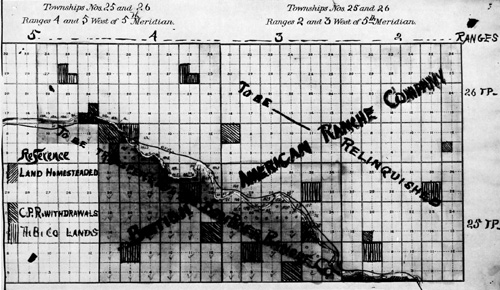
28 Map showing the disposition of the British
American Ranche Company lease, April 1887.
(Public Archives of Canada.)
|
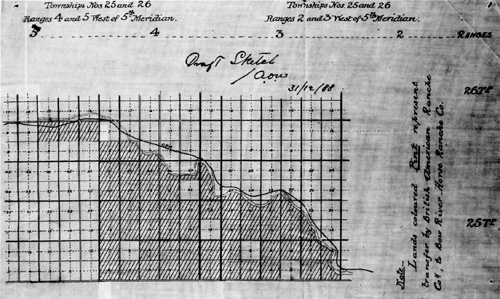
29 Map of Bow River horse ranch, December
1888. Lands coloured pink on the original are indicated by hatching.
(Public Archives of Canada.)
|
The disappearance of the sheep-ranching operations of the British
American ranch was not an isolated incident comparable to the withdrawal
of the cattle operations to the south. Despite McEachran's observation
in 1887 that the industry was "eminently successful,"83 by
1889 the commissioner of the North West Mounted Police could state that
"The large sheep ranches are disappearing and I think the industry will
resolve itself into keeping small flocks on
homesteads."84
Had the world price for wool remained high, the British American
Ranche Company would have fought to stay in business. As it was, the
nuisance of squatters and wolves combined with a generally unprofitable
world trade situation made it simply not worthwhile to continue in
operation.
|

